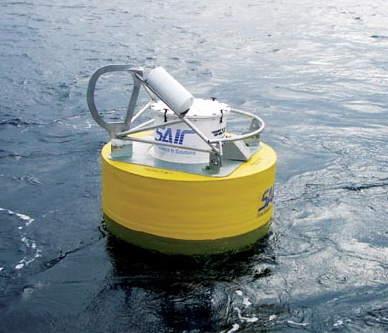 The SAIC Tsunami Buoy (STB) was deployed in October 2006, approximately 200 nautical miles west of San Diego,the U.S.A., in 3,876 meters of water. The location is approximately 28 nautical miles from a National Oceanographic and Atmospheric Administration (NOAA) Deep-ocean Assessment and Reporting of Tsunami (DARTTM) buoy that has been used in part to evaluate the performance of the STB. The genesis of SAIC developing a tsunami warning capability began after the December 26, 2004 Indian Ocean tsunami tragedy and has continued to build and mature since that catastrophe. With the goal of developing an end-to-end tsunami warning capability that can be integrated into international disaster warning systems, SAIC engineers determined that the cornerstone of this effort would be the development of a technically advanced, commercially available, deep-ocean sensor that could match the capabilities of the NOAA DARTTM system that currently protects the coastal United States. Additionally, the STB has been designed to handle additional meteorological and oceanographic sensors that could be required in various ocean regions of the world. As a major support contractor to NOAA? National Data Buoy Center, SAIC has extensive experience building, deploying and maintaining the DARTTM buoys. The SAIC STB team built on this background as well as decades of experience designing and deploying ocean sensors in support of other U.S. government agencies to develop a commercial version of the DARTTM buoy to meet the emerging requirements of the international marketplace. The SAIC Tsunami Buoy (STB) was deployed in October 2006, approximately 200 nautical miles west of San Diego,the U.S.A., in 3,876 meters of water. The location is approximately 28 nautical miles from a National Oceanographic and Atmospheric Administration (NOAA) Deep-ocean Assessment and Reporting of Tsunami (DARTTM) buoy that has been used in part to evaluate the performance of the STB. The genesis of SAIC developing a tsunami warning capability began after the December 26, 2004 Indian Ocean tsunami tragedy and has continued to build and mature since that catastrophe. With the goal of developing an end-to-end tsunami warning capability that can be integrated into international disaster warning systems, SAIC engineers determined that the cornerstone of this effort would be the development of a technically advanced, commercially available, deep-ocean sensor that could match the capabilities of the NOAA DARTTM system that currently protects the coastal United States. Additionally, the STB has been designed to handle additional meteorological and oceanographic sensors that could be required in various ocean regions of the world. As a major support contractor to NOAA? National Data Buoy Center, SAIC has extensive experience building, deploying and maintaining the DARTTM buoys. The SAIC STB team built on this background as well as decades of experience designing and deploying ocean sensors in support of other U.S. government agencies to develop a commercial version of the DARTTM buoy to meet the emerging requirements of the international marketplace.
On November 15, 2006, during this test period, the Kuril Islands experienced an 8.3 magnitude earthquake which generated a small tsunami that propagated across the Pacific Ocean. Approximately nine hours later the SAIC tsunami buoy detected and reported the first tsunami waves arriving in the area. The nearby NOAA DARTTM also detected the tsunami waves. Just as in earlier laboratory testing throughout the Kuril Island tsunamigenic event, the SAIC tsunami buoy demonstrated it can match the operational capabilities of NOAAs DARTTM system during actual tsunami conditions. SAIC is a leading provider of scientific, engineering, systems integration and technical services and solutions to all branches of the U.S. military, agencies of the Department of Defense, the intelligence community, the U.S. Department of Homeland Security and other U.S. Government civil agencies, as well as to customers in selected commercial markets. With more than 44,000 employees in over 150 cities worldwide, SAIC engineers and scientists solve complex technical challenges requiring innovative solutions for customers mission-critical functions. SAIC had annual revenues of US$7.8 billion for its fiscal year ended January 31, 2006.
For more info., contact to email swm@infothe.com
ⓒ2007 www.SecurityWorldmag.com. All rights reserved. |



